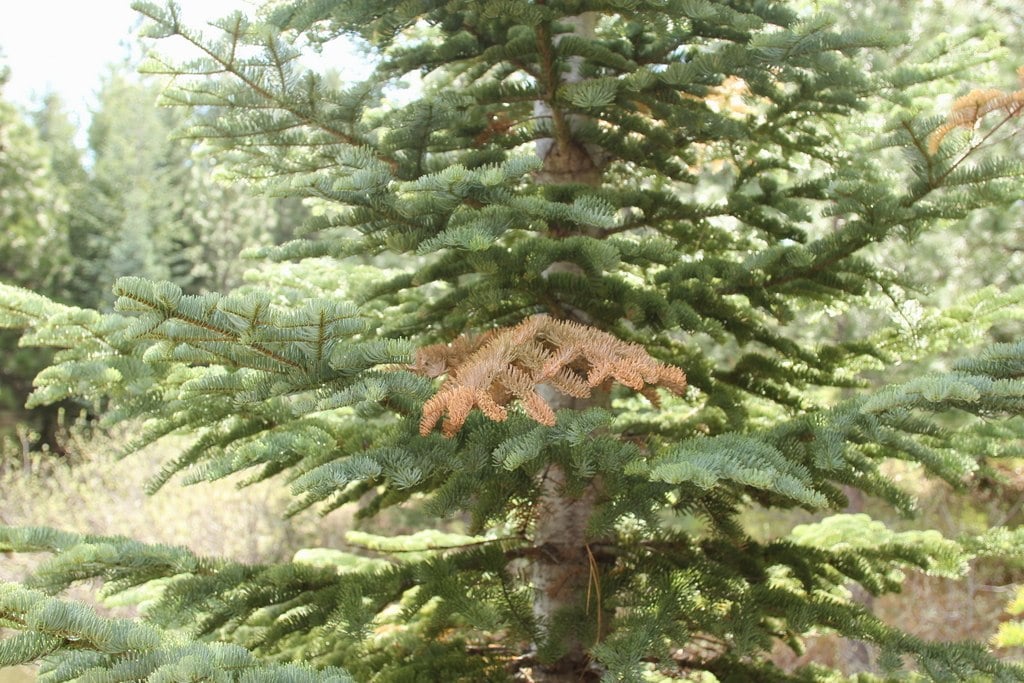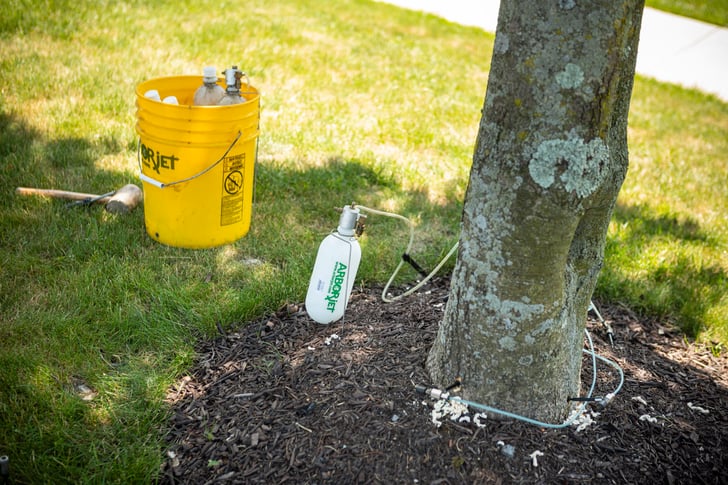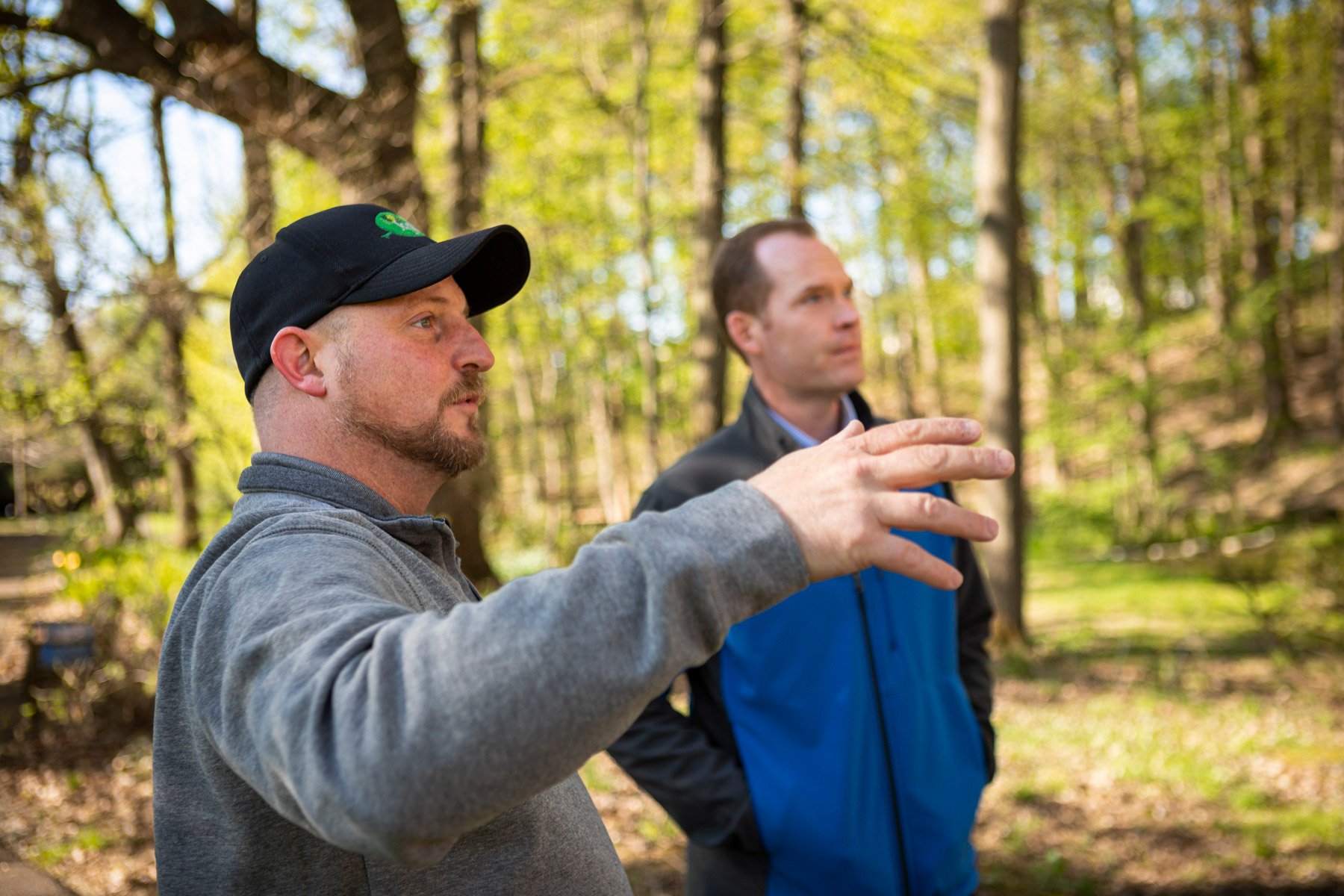The trees on your property are a tremendous asset. But understanding their needs and what’s normal (as well as what’s not normal) can be complicated. You want what’s best for your trees but you might not know what that involves.
Different tree species can have different issues that need to be on your radar.
If you have any evergreen conifer species on your property like pines, spruce, or firs, you might be concerned about conifer needle loss. While it’s normal for conifers to shed a small amount of needles, any major loss could be a sign of a disease or another problem.
In this article, we’ll talk about conifer needle drop, when it’s normal, and what signs of trouble you should watch for.
What are Conifers?
You probably learned a little bit about trees at some point in your early school years. But for those who don’t remember, conifers are trees that bear their seeds in cones. Most conifers have needle-like leaves and most are evergreen, meaning they retain most of their needles throughout the year.
That being said, some needle drop is normal, which we’ll explore further in this article.
Some of the conifers that are popular in residential landscapes include spruce, pine, junipers, cedar, and cypress trees.
Any time that you’re selecting a tree for your property, you should consider whether your microclimate will be able to support that tree’s growth and health. But in general, many conifer species make good choices for homeowners as they tend to be easy to care for and have many benefits.
Understanding Conifer Needle Loss
Evergreen conifers stay green and retain most of their needles year-round, which is why it can be confusing when you find needles on the ground. But even evergreen conifers do some normal shedding of their oldest needles.
The difference between deciduous trees (which shed their leaves all at once, in the fall), is that evergreen conifers drop needles in cycles, which is why they’re able to maintain a pretty full look even with some evergreen needle drop.
%20CC.jpg?width=4000&height=3000&name=Norway%20Spruce%20(Picea%20abies)%20CC.jpg)
Most conifers start shedding older needles around three years after they’ve been produced. But different species can have different timelines.
Conifers typically start dropping needles in the late summer. This can continue through the fall. Some conifers shed more needles than others.
Which Evergreens Drop Needles?
There are more than 600 species of conifers around the world. All species of conifers drop their needles, it’s just that some do it more frequently than others.
The reason for conifer needle drop is so that these plants can conserve more resources ahead of the winter months. This is the same reason why deciduous trees shed their leaves (it’s just that they shed all of them).
Needle drop also makes room for new needle growth and is part of these trees’ natural cycle.
White pines are probably the most dramatic as the number of their yellow needles will outnumber new growth. For that reason, this species’ shedding tends to be the most noticeable. While it can be alarming, this is something that your White Pine is made to do and new needle growth will fill in.
White pines typically shed needles every two to three years.
%20CC.jpg?width=3456&height=2298&name=White%20Pine%20(Pinus%20strobus)%20CC.jpg)
Spruce, on the other hand, shed their needles in a progressive fashion so they’re able to maintain a fuller and greener look, even during the late summer to fall when other conifers are actively shedding.
This is also true for fir trees. You might not even notice that your fir has shed if you’re not looking at the ground.
When Should I Worry about Conifer Needle Loss?
Since it’s normal for your conifers to shed some needles, you might be wondering how you can tell if something is actually wrong.
Some problematic situations that can lead to conifer needle drop include drought, heat, and even overwatering. People often don’t realize that too much water can be just as bad for their trees as too little. When you overwater a tree, you are essentially drowning its roots.

There is also needle drop disease, a fungus that can lead to unhealthy needle loss, which is a potential problem for spruce trees. Overwatering can also play a role in disease conditions.
Some signs of concerning needle loss include:
- Yellowing or browning at the branch tips. Usually, the new growth occurs at the branch tips and remains green and healthy. But if this is now turning brown or yellow, there could be something more going on.
- Extensive needle drop at a time when your conifers aren’t usually dropping. Again, most needle drop occurs in the late summer and fall. During the active growing season (spring), most species aren’t shedding.
- Dead branches or large-scale dieback.
- Signs of a pest problem (besides needle drop) like chewed areas or signs of active insects.
Unfortunately, like many other tree species, problems can go unnoticed until they’re severe. For that reason, it’s beneficial to make sure that your conifers are being regularly inspected (along with any other trees on your property).
Whenever possible, you want to catch problems early or even implement preventive care.
Understanding How Needle Drop Disease Leads to Needle Loss
As we mentioned above, there are also disease conditions that can lead to unhealthy (and unintended) needle loss.
Rhizosphaera is a fungus disease that primarily affects spruce trees. It will cause the needles to turn brown and fall off. Spruce trees that are already struggling due to drought or other poor environmental conditions are most likely to be seriously affected by this disease.
There are other Needlecast diseases that can lead to trouble for your conifers, causing large amounts of their needles to fall off prematurely. These fungal infections will spread through the branches, killing large areas of the tree until it dies completely.
Evergreen tree disease is always better controlled in the very early stages before they’ve had a chance to take hold of the tree. Even better, you want to do what you can to prevent these problems in the first place.
Regular, repeatable foliar applications or deep-root treatments can help protect your needled evergreens from infestation. Good cultural practices like watering in drought and mulching for soil moisture retention can keep your evergreens from becoming stressed and susceptible to disease.

Timing is everything. If your evergreens are showing signs of common diseases, a care plan that starts now and continues regularly can help to prevent total tree loss or the spread of disease to other parts of the landscape.
Pruning is often part of the process of removing disease from a tree. By selectively cutting out damaged areas, it’s possible to restore your evergreens. However, this is best left to a professional as you don’t want to make an existing problem worse. If a tree is heavily infected, it might not be possible to save it.
Help Preserve Your Conifers with Professional Tree Care
At the end of the day, you just want what’s best for the trees on your property.
There’s a good chance that conifers are just one of many tree types you might have around your home. It can be complicated keeping up with what all of your different trees need which is why it makes sense to work with a pro.

As we’ve mentioned, regular inspections are always vital when it comes to keeping an eye on your trees and making sure there’s not a problem going on under your nose. Often, problems don’t become evident until they are severe and you want to do what you can to prevent that from happening.
When you hire a professional tree care service, they can perform assessments and help create a long-term plan that will provide the care needed for your trees. They can also help advise on what conifer needle drop is normal (and what’s not) so that you’re better educated going forward.
We believe you deserve to feel confident that your trees are getting everything they need. With the right choice in a tree company, you’ll be set up for success.
With the right care for your trees, you’ll gain valuable peace of mind. If you’re interested in having your trees inspected and their health assured, contact us for a free consultation or give us a call at 833-JTE-TREE.
Image Source | Norway Spruce, White Pine, Cytospora




